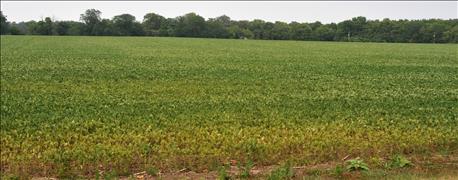
A good portion of Indiana was on the wet side through most of July. However, there were dry pockets, especially in northern Indiana. If dry weather sets up now, there are specific soybean challenges to watch for.
The most obvious is actually a mite — the two-spotted spider mite. “We found a few spider mites affecting soybeans on sandy soil earlier in the season,” says Betsy Smith, agronomist for Ceres Solutions in west-central Indiana. She is also an Indiana Certified Crop Adviser.

BE ON GUARD: If you farm in one of the dry pockets in the state, keep your eyes peeled for two-spotted spider mites that cause bronzing of leaves, as well as other dry weather challenges. (Photo courtesy of John Obermeyer, Purdue University entomologist)
“Spider mites are always out there, and most of the time, soybeans and spider mites coexist,” Smith says. “During extended dry spells, plant sap becomes concentrated, mite populations explode and that reduces plant growth. Soybean leaves take on a sandblasted appearance.”
Others sometimes describe it as bronzing of the leaves. Mite infestation typically starts on the outside of the field and moves in, Smith says. However, sometimes you can find them in the middle of the field, especially where there is a heavy chickweed infestation.
Control consists of spraying miticides, Smith says. Two options are Cygon and liquid Lorsban. You could also use liquid chlorpyrifos.
At least two diseases tend to show up more in soybeans during dry weather spells, Smith adds. They are powdery mildew and charcoal rot.
Cool, cloudy conditions with low humidity favor powdery mildew, especially in later-planted soybeans. Many varieties are resistant, and many fungicides can control it.
Charcoal rot was thought to be a disease of drier soil types, but it can now be found in any soils if the organism is present. It typically shows up when it’s dry during the R1 through R7 soybean growth stages, Smith says.
Infected plants are stunted after flowering, often in patches. Stems become gray to silvery, Smith says. Fungicides don’t control charcoal rot. Stems will show black streaking in the woody areas when split open. Tiny structures called sclerotia form on lower stems and taproots. Corn is a host, too. Small grains tend to reduce sclerotia numbers.
About the Author(s)
You May Also Like




